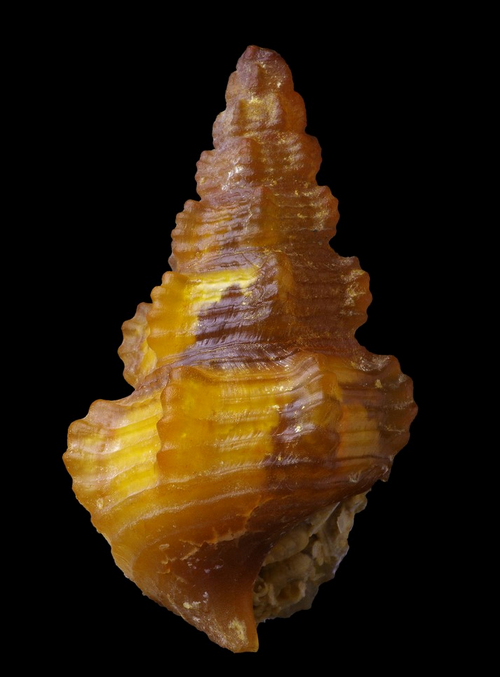Source: Science Nature Page.
Source: Science Nature Page.
More Posts from Iphleandro-blog and Others

The “Squidworm” is believed to be a transitional organism from benthic worms to free-swimming pelagic worms. They are named Squidworms due to their tentacle-like branchiae and palps.
(source)

sports walkman by picogram_art

Agatized Cerithium (Eocene) - Assa, Morocco

Glacial Striations and Stromatolites and Geology, oh my!
This photo is a two-fer: two awesome geology features in one! On the surface of this rock you will notice faint lines that stretch from the lower left hand corner of the image to the upper right hand corner. These lines are called glacial striations and they form as a glacier scratches the rock surface as it moves.
The rock surface that was scratched by the moving glacier represents an entirely different time, waaay before the glaciers, when stromatolites dotted the shoreline of an ancient water body that covered Montana. The circles that you see in the rock are the tops of stromatolites, formed by ancient cyanobacteria.
A great place to see stromatolites and striations is on the Grinnell Glacier Trail. For your best chance of seeing these features free of snow, try hiking the trail in late July or August. NPS Photo
[Image Description: Lines and circles etched into a rock surface.]










More fossils from the Lapworth Museum of geology!
Top to bottom:
- Cambrian (Marrella splendens, Hurdia victoria, trilobites)
- Devonian fish (Pteraspis, Drepanaspis, Bothriolepis, Cephalaspis)
- Permian (Dimetrodon, Mesosaurus)
- Quarternary (Smilodon)
Japanese Ice-cream Machine.



Mood




You and I had a fight recently.
-
 sauravchandra94 reblogged this · 5 years ago
sauravchandra94 reblogged this · 5 years ago -
 sauravchandra94 liked this · 5 years ago
sauravchandra94 liked this · 5 years ago -
 for-pebbles reblogged this · 5 years ago
for-pebbles reblogged this · 5 years ago -
 milencita liked this · 5 years ago
milencita liked this · 5 years ago -
 mathlover00 reblogged this · 6 years ago
mathlover00 reblogged this · 6 years ago -
 shriyash51 liked this · 6 years ago
shriyash51 liked this · 6 years ago -
 sparklzlol reblogged this · 6 years ago
sparklzlol reblogged this · 6 years ago -
 lambcow liked this · 6 years ago
lambcow liked this · 6 years ago -
 javathisscript reblogged this · 6 years ago
javathisscript reblogged this · 6 years ago -
 ghtx reblogged this · 7 years ago
ghtx reblogged this · 7 years ago -
 windbournenomad-blog reblogged this · 7 years ago
windbournenomad-blog reblogged this · 7 years ago -
 windbournenomad-blog liked this · 7 years ago
windbournenomad-blog liked this · 7 years ago -
 handsome-69 liked this · 7 years ago
handsome-69 liked this · 7 years ago -
 denizcan01 liked this · 7 years ago
denizcan01 liked this · 7 years ago -
 avivagabriel liked this · 7 years ago
avivagabriel liked this · 7 years ago -
 swaglessgamer reblogged this · 7 years ago
swaglessgamer reblogged this · 7 years ago -
 swaglessgamer liked this · 7 years ago
swaglessgamer liked this · 7 years ago -
 annnaae liked this · 7 years ago
annnaae liked this · 7 years ago -
 spswarm liked this · 7 years ago
spswarm liked this · 7 years ago -
 angeloa92 liked this · 7 years ago
angeloa92 liked this · 7 years ago -
 proactive-procrastinator reblogged this · 7 years ago
proactive-procrastinator reblogged this · 7 years ago -
 what-the-hyphen reblogged this · 7 years ago
what-the-hyphen reblogged this · 7 years ago -
 what-the-hyphen liked this · 7 years ago
what-the-hyphen liked this · 7 years ago -
 makethebestofit96 reblogged this · 7 years ago
makethebestofit96 reblogged this · 7 years ago -
 rainbows-and-coffee reblogged this · 7 years ago
rainbows-and-coffee reblogged this · 7 years ago -
 rainbows-and-coffee liked this · 7 years ago
rainbows-and-coffee liked this · 7 years ago -
 carfentanyll liked this · 7 years ago
carfentanyll liked this · 7 years ago -
 jcm888 reblogged this · 7 years ago
jcm888 reblogged this · 7 years ago -
 ultra-dicapri liked this · 7 years ago
ultra-dicapri liked this · 7 years ago -
 nymnwales liked this · 7 years ago
nymnwales liked this · 7 years ago -
 jcm888 reblogged this · 7 years ago
jcm888 reblogged this · 7 years ago -
 edgarabbit reblogged this · 7 years ago
edgarabbit reblogged this · 7 years ago -
 thatcandleontheflooroverthere liked this · 7 years ago
thatcandleontheflooroverthere liked this · 7 years ago -
 ethicfail reblogged this · 7 years ago
ethicfail reblogged this · 7 years ago -
 johnofocus reblogged this · 7 years ago
johnofocus reblogged this · 7 years ago -
 iphleandro-blog reblogged this · 7 years ago
iphleandro-blog reblogged this · 7 years ago